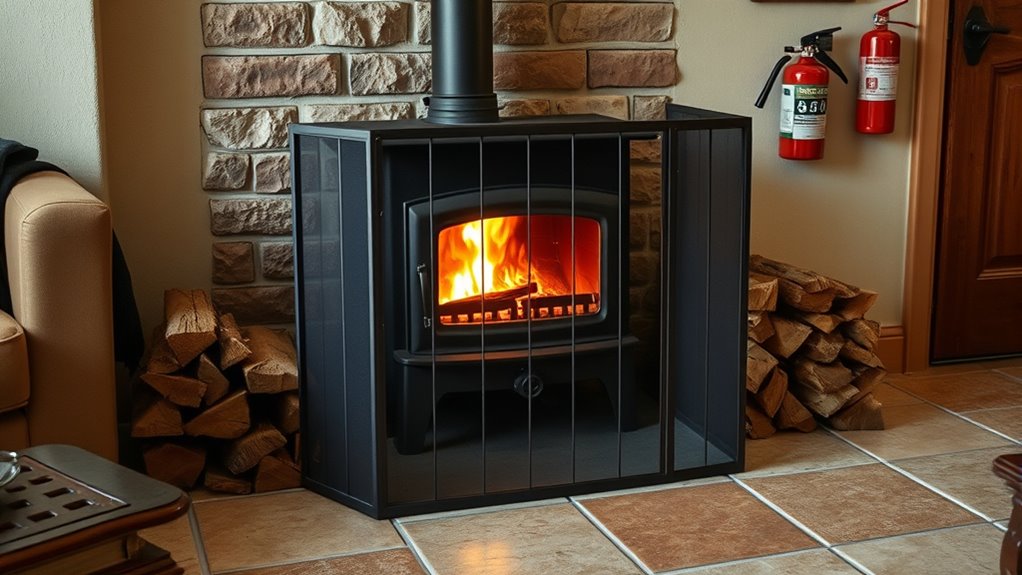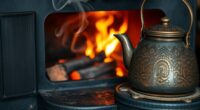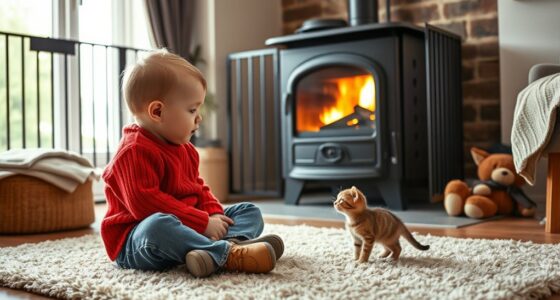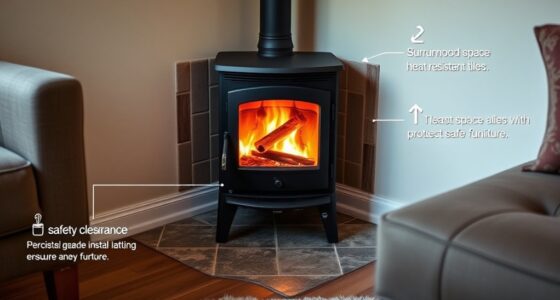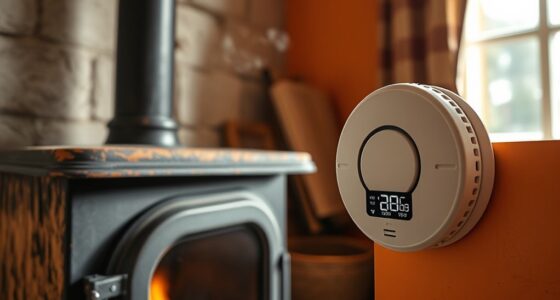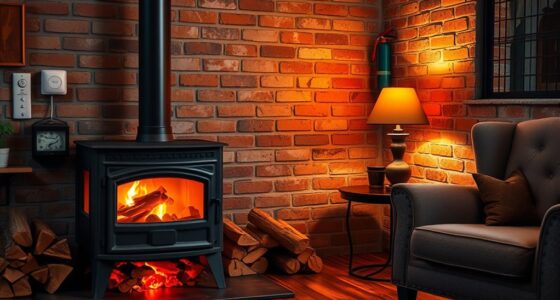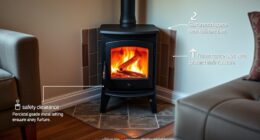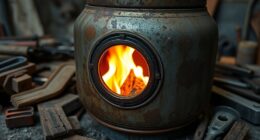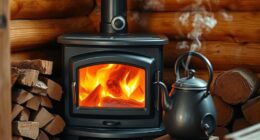To stay safe around your wood stove, guarantee proper installation with enough clearance from combustible materials, and always use a non-combustible base. Regularly inspect and clean your chimney to prevent creosote buildup, which can cause fires. Always start fires safely, dispose of ashes properly, and maintain good ventilation to avoid dangerous fumes. Keep safety devices like smoke and carbon monoxide detectors active. Those tips only scratch the surface—keeping your home safe takes ongoing care and attention.
Key Takeaways
- Maintain at least 36 inches of clearance from combustible materials around the stove.
- Regularly clean chimneys and stove to prevent creosote buildup and fire hazards.
- Use approved hearth protectors and install the stove on non-combustible flooring.
- Keep children and pets away from hot surfaces and never leave fires unattended.
- Install and regularly test smoke and carbon monoxide detectors for early fire and gas leak detection.
Proper Installation and Placement of Your Stove

To guarantee safe operation, you must install your wood stove correctly and position it properly within your space. Start by maintaining a minimum clearance of 36 inches between the stove and combustible materials like walls, furniture, or draperies. This clearance prevents fire hazards and ensures proper airflow. During stove installation, place the unit on an approved, non-combustible stove board to protect your flooring from heat and sparks. Be sure the chimney is positioned away from combustibles and meets height requirements, typically at least 3 feet above the roof penetration. Follow the manufacturer’s guidelines precisely for installation procedures, clearances, and venting. Regularly inspect your setup for signs of deterioration or obstructions, and have a professional verify your stove installation annually for continued safety. Proper venting is essential to prevent dangerous carbon monoxide buildup and ensure efficient operation, and ensuring compliance with local safety regulations helps avoid penalties and enhances overall safety. Additionally, using appropriate insulation around the stove can help improve energy efficiency and reduce heat loss. Incorporating proper airflow management can further optimize stove performance and safety, while attention to system durability can extend the lifespan of your setup and maintain safe operation over time.
Regular Chimney Maintenance and Creosote Prevention
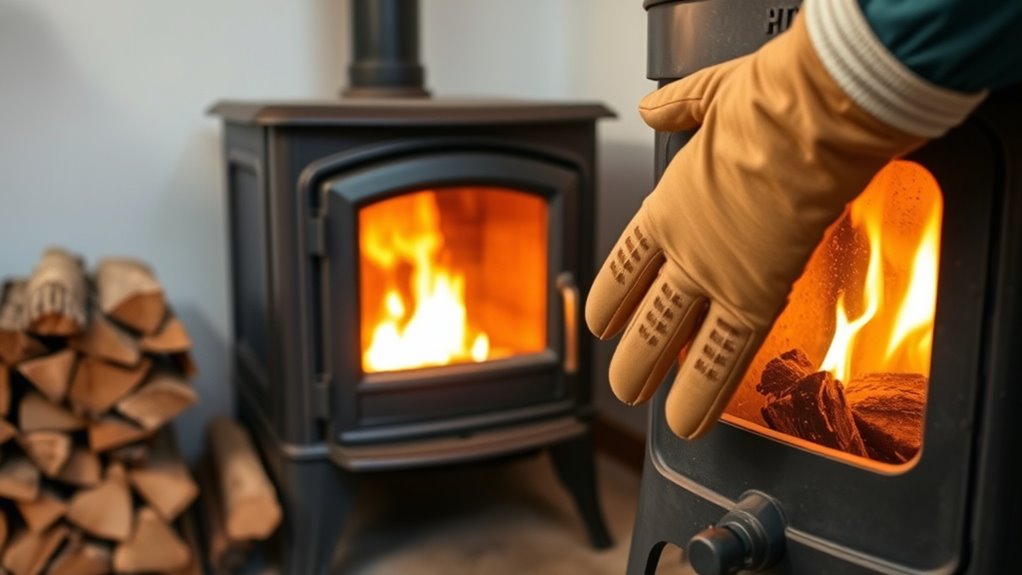
Regular chimney maintenance is essential for safety and efficient wood stove operation. To prevent creosote buildup, you should schedule regular chimney cleaning with a stiff wire brush, especially if you use high-efficiency stoves that operate at lower flue temperatures. Using dry, seasoned firewood (below 20% moisture) also considerably reduces creosote formation. Maintaining a flue temperature above 250°F during fires helps prevent creosote deposits from condensing. Proper knowledge of testing methodologies and adherence to best practices can further enhance safety measures. Conducting regular inspections can also help identify potential pollutant emissions that contribute to health and environmental issues. Additionally, understanding industry trends can help you stay informed about new safety equipment and techniques. Being aware of water vapor emissions is important, as excessive moisture can increase creosote buildup. Proper ventilation and air quality management in the vicinity of your stove are also crucial for safety. Here’s a visual overview:
| Maintenance Task | Key Benefit | Recommended Frequency |
|---|---|---|
| Chimney cleaning | Removes creosote buildup | Every 1-2 years |
| Use seasoned firewood | Lowers creosote formation | Each fire |
| Check flue temperature | Prevents creosote deposits | During each burn |
| Professional inspection | Detects damage and buildup | Annually |
| Stove maintenance | Ensures efficient operation | Regularly |
Safe Fire Starting and Ash Disposal Techniques
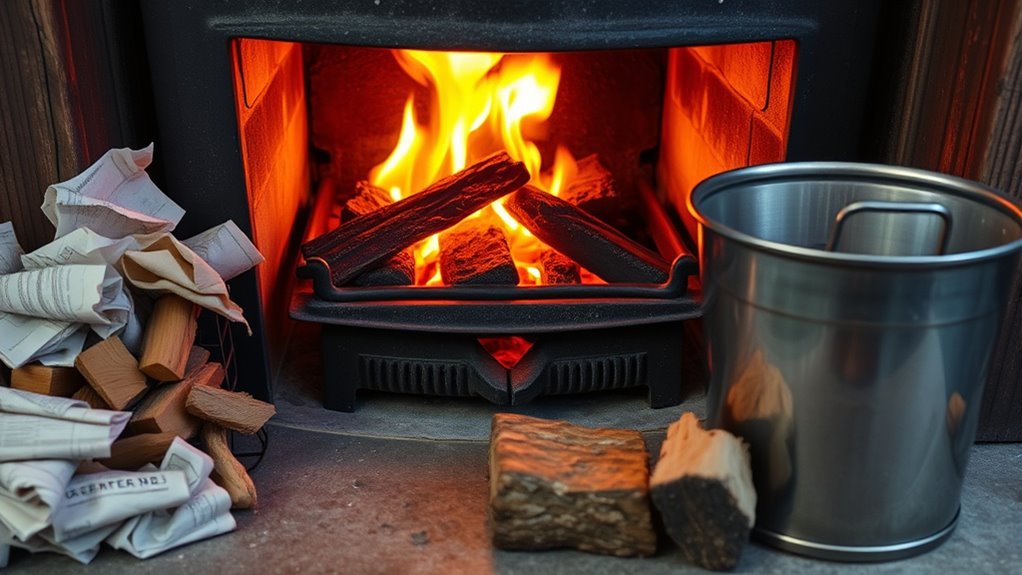
Starting a fire safely is vital to prevent accidents and guarantee efficient heating. Use safe starters like dry paper, kindling, or fatwood—never kerosene or gasoline—to ignite your fire. This ensures fire safety and reduces the risk of uncontrolled flames. When it’s time to dispose of ashes, always place them in a metal container with a lid, on a non-combustible surface, and make sure they are completely cool before handling. Never use water to douse hot ashes, as it can create dangerous steam and spread embers. Keep ashes away from combustible materials, storing them in a fire-resistant container until final disposal. Regularly check that ashes are fully cooled to prevent accidental fires, maintaining safe fire practices around your wood stove. Additionally, understanding contrast ratio helps ensure your stove area is well-lit and safe, preventing mishaps caused by poor visibility. Proper ash disposal techniques are essential to avoid unintended fires and ensure a secure environment around your heating area. Incorporating appliance maintenance plans can help keep your heating equipment in optimal condition, reducing the risk of malfunctions that could lead to fire hazards. Performing routine inspections and cleaning can also prevent buildup of creosote, which is crucial for safe and efficient stove operation. Regular cleaning and maintenance not only extend the lifespan of your stove but also significantly reduce the risk of dangerous fire hazards caused by accumulated deposits.
Ensuring Adequate Ventilation and Exhaust Systems
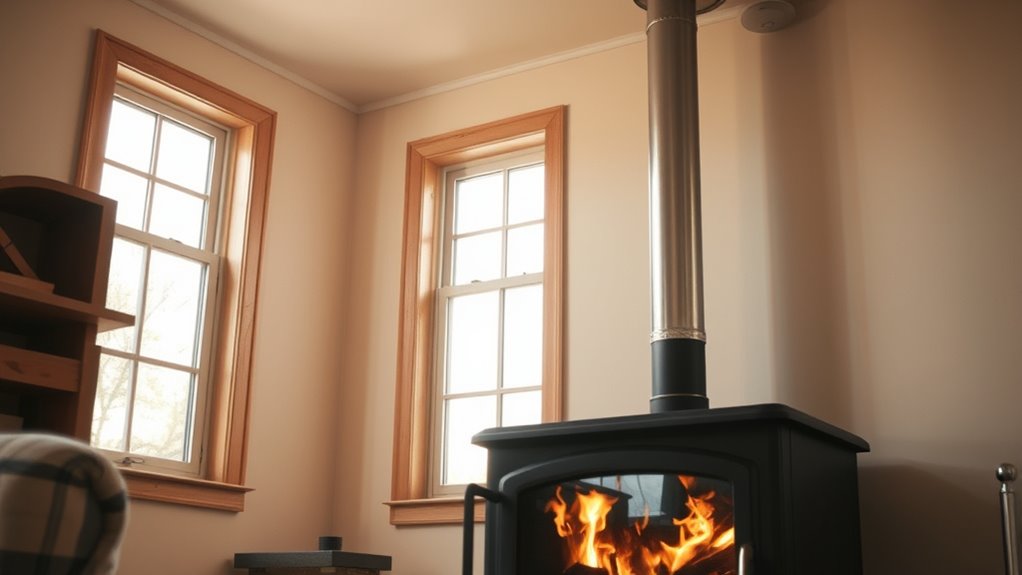
Ensuring adequate ventilation and exhaust systems is essential for safe and efficient wood stove operation. Your chimney flue must be as short and straight as possible, avoiding walls and obstructions to promote proper draft and efficient exhaust flow. The vent should exit safely into a chimney flue that’s correctly sized, installed according to manufacturer guidelines, and free of blockages like bird nests or debris. Regular seasonal inspections are critical to check for cracks, creosote buildup, or damage that could cause dangerous backflow or blockages. Incorporating proper venting techniques can help prevent issues such as poor draft, smoke inside your home, or hazardous emissions. Remember, professional installation guarantees proper venting, preventing issues such as poor draft, smoke inside your home, or hazardous emissions. Additionally, understanding ventilation standards can ensure your system complies with safety regulations and operates optimally. Utilizing advanced monitoring tools can provide real-time data to detect and address ventilation issues promptly, enhancing overall safety and efficiency.
Essential Housekeeping and Safety Practices
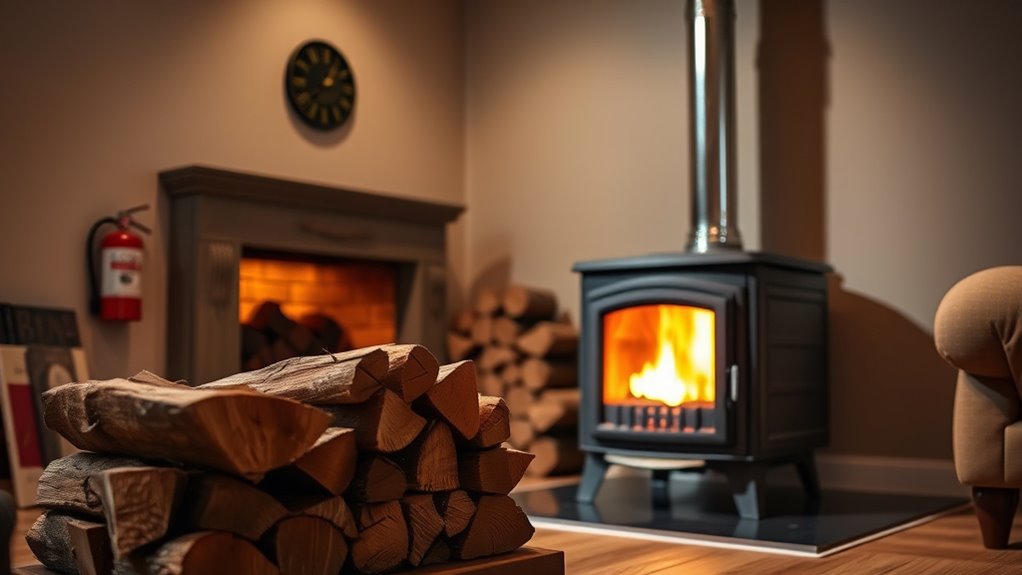
Maintaining a safe wood stove environment requires diligent housekeeping and safety practices. Regularly clean creosote buildup from the chimney and around the stove to prevent fire hazards. Keep combustible items like curtains, furniture, and paper at least 36 inches away from the stove or fireplace inserts to reduce the risk of ignition. Use a fire-resistant hearth pad or floor protector beneath and in front of the stove to shield your flooring from heat and sparks. Always remove ash and debris from around the stove and hearth to ensure proper airflow and reduce fire hazards. Never leave a fire unattended, and make sure the fire is completely out before leaving or sleeping. Keep children and pets away from hot surfaces, even after the fire is extinguished. Additionally, staying informed about fire safety tips and proper maintenance routines can significantly enhance your home’s safety around wood stoves. Regularly inspecting and maintaining your stove and chimney can also prevent dangerous buildups and ensure efficient operation, contributing to overall fire prevention. Incorporating appropriate safety equipment like smoke and carbon monoxide detectors further enhances your home safety measures. Proper ventilation practices are also essential to prevent the buildup of dangerous gases inside your home. Awareness of wood stove types can help you choose the safest and most efficient model for your needs.
Frequently Asked Questions
How Much Space Do You Need to Leave Around a Wood Burning Stove?
You need to leave at least 36 inches of clearance around your wood stove, but check the manufacturer’s guidelines for exact measurements. For unprotected walls or ceilings, aim for a minimum of 18 inches to prevent overheating. Use approved heat shields or wall protectors if space is tight. Confirm the stove sits on a non-combustible floor protector extending adequately, and verify proper stovepipe and chimney clearances for safe operation.
How to Fireproof Around a Wood Stove?
You might think placing fire-resistant materials around your stove is enough, but true fireproofing requires more. Start by installing a non-combustible hearth pad extending at least 18 inches in front and 8 inches on the sides. Keep all combustible items at least 36 inches away, and use wall shields or panels for added protection. Regularly inspect and clean your stove and surrounding area to prevent fire hazards.
What Is the 3:2-10 Rule for Wood Stoves?
The 3:2-10 rule helps you keep your space safe when using a wood stove. You should maintain at least 3 feet of clearance from the stove’s top to the ceiling, 2 feet on each side, and 10 feet from any combustible materials. This guarantees proper ventilation, prevents heat buildup, and reduces fire risks, keeping you and your home protected during stove operation.
How Much Clearance Do You Need Around a Wood Burning Stove?
You should maintain at least 36 inches of clearance around your wood stove to prevent fire hazards. Keep the stovepipe at a minimum of 18 inches from unprotected ceilings and walls for safe operation. Place the stove on a non-combustible floor protector, and use approved shields for wall protection. Always follow manufacturer instructions and consult professionals to make certain of proper clearances and safe installation.
Conclusion
By following these fire safety tips, you create a cozy, crackling warmth that won’t turn into tragedy. Picture your home filled with gentle, flickering light from your stove, with clear vents guiding smoke safely outside. Keep your space tidy and your chimney clean, like a guardian watching over your hearth. When you prioritize proper installation, maintenance, and safe practices, you’ll enjoy the comforting glow of your wood stove without risking a fiery mishap.

